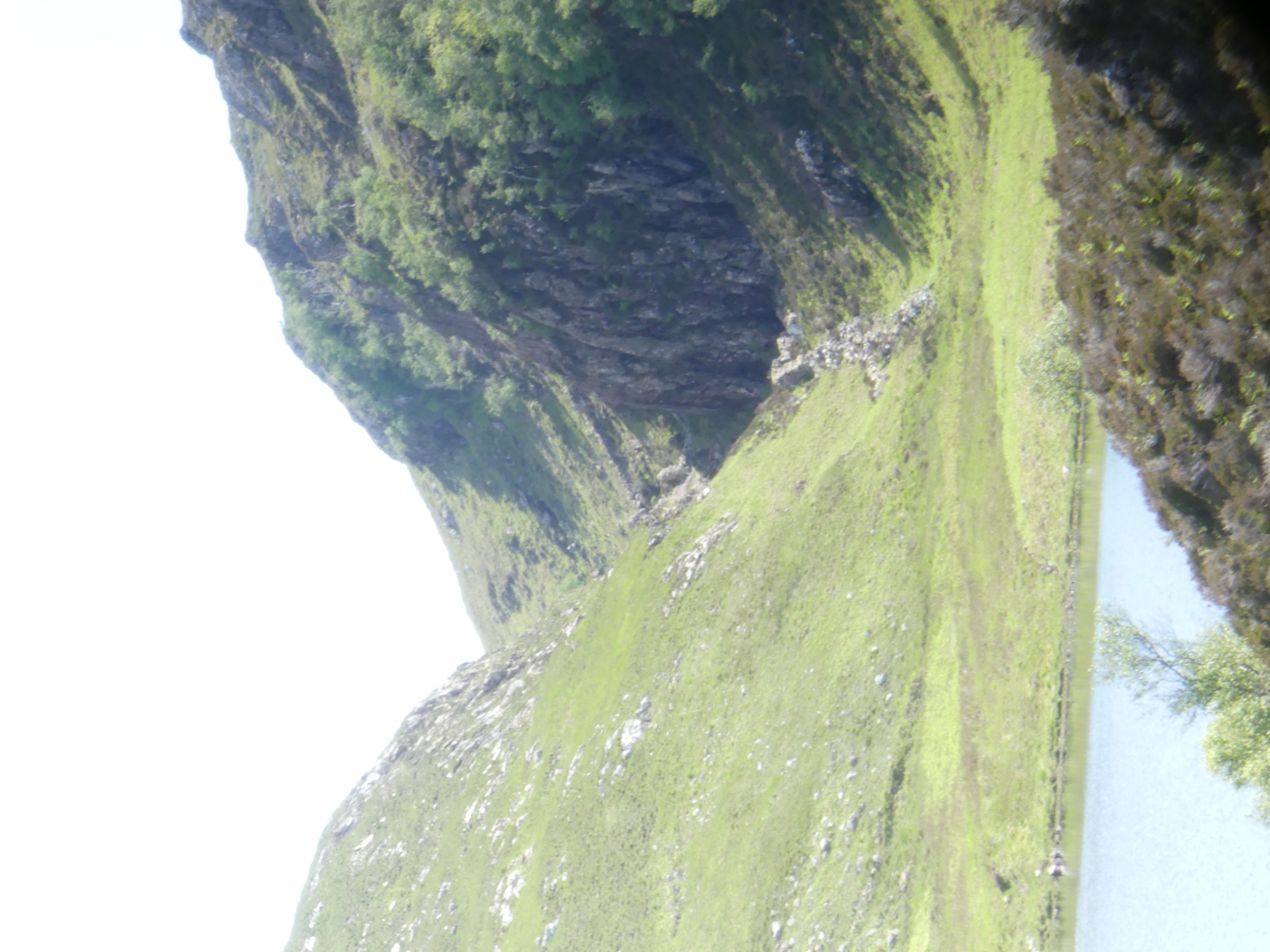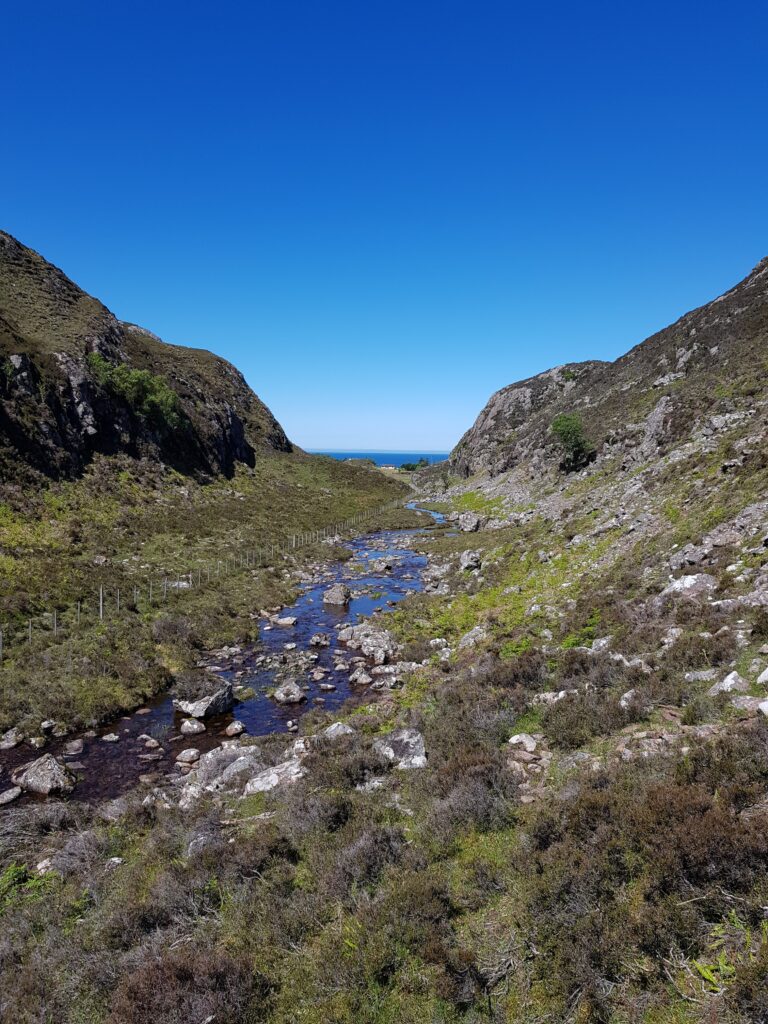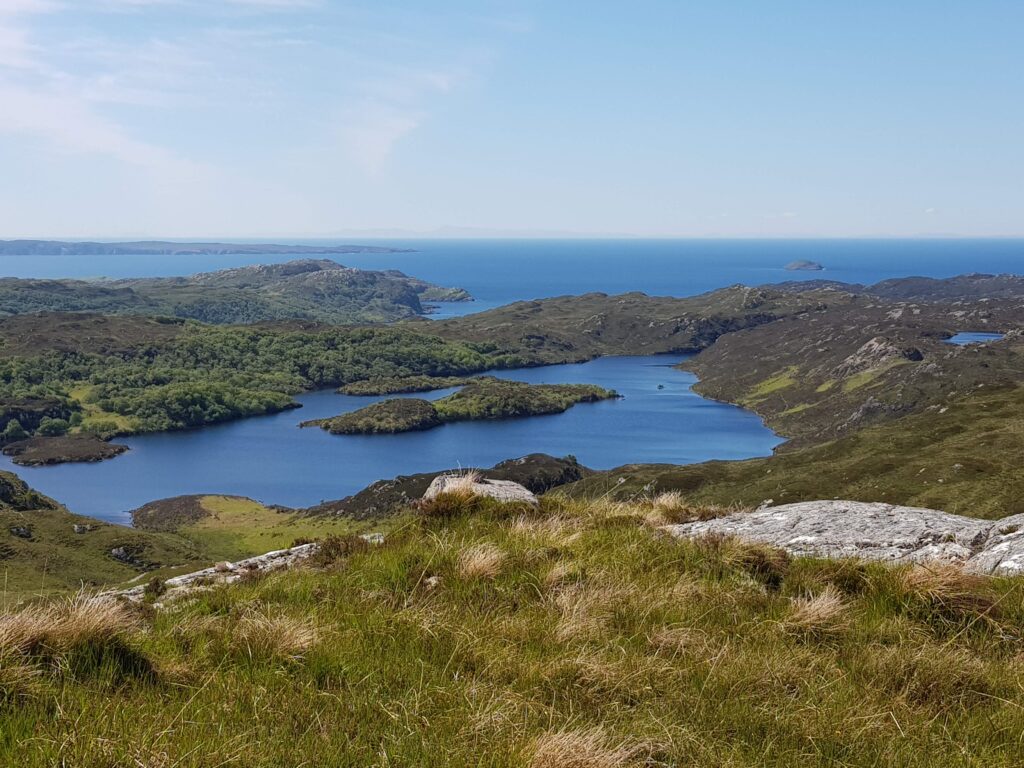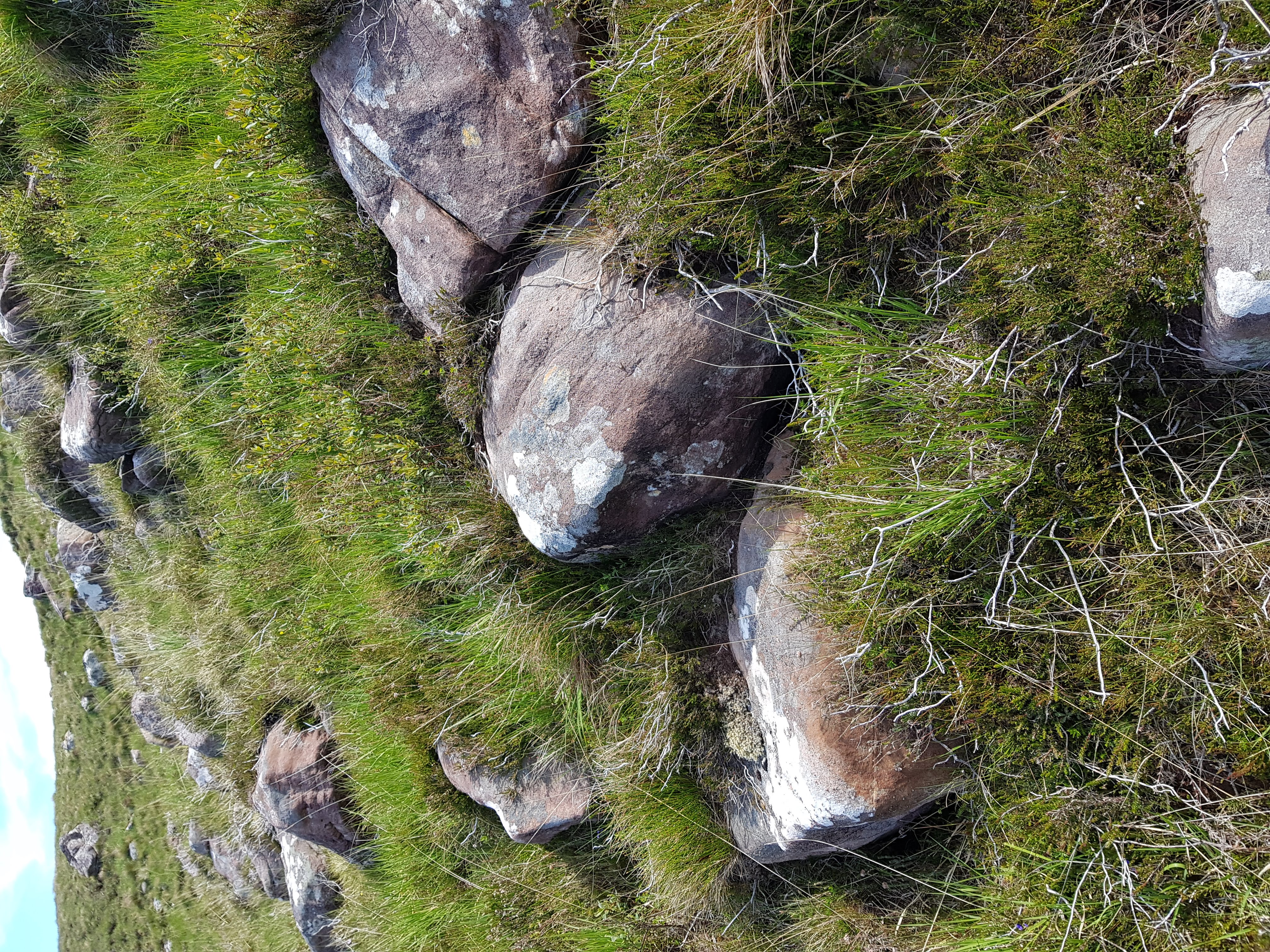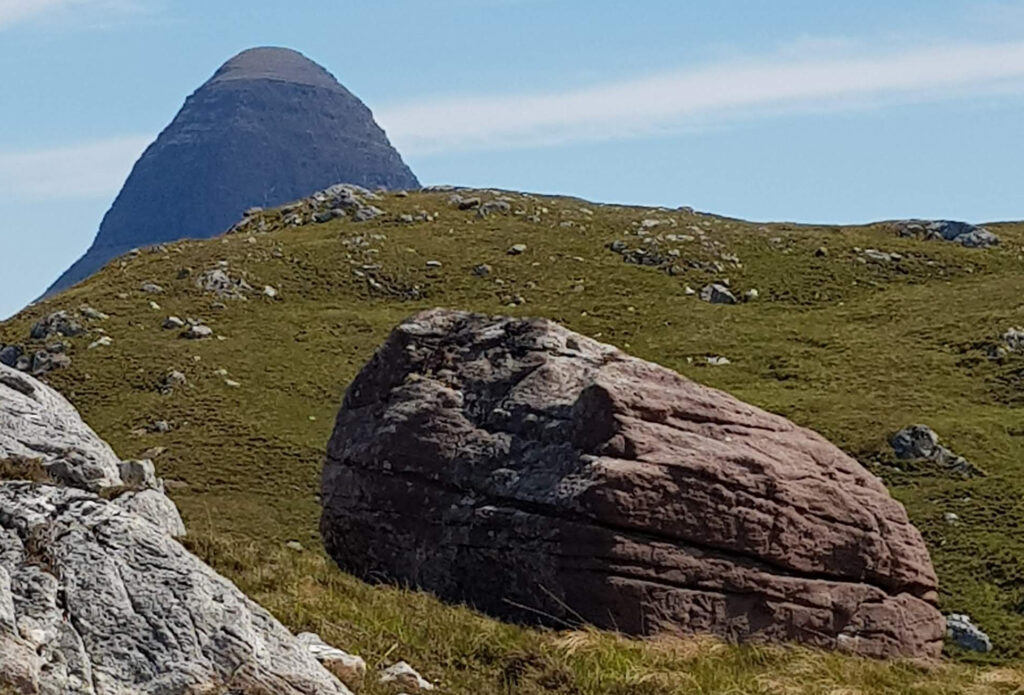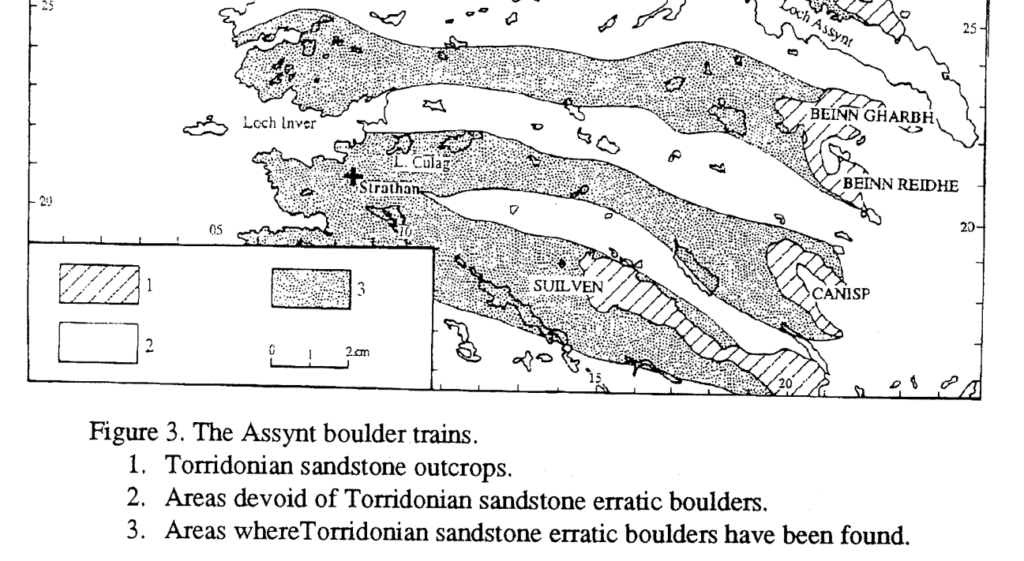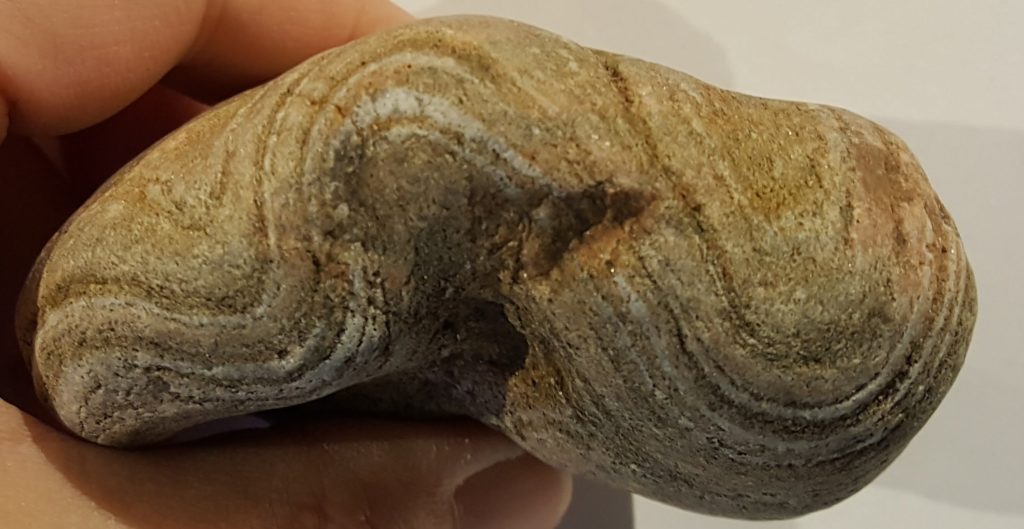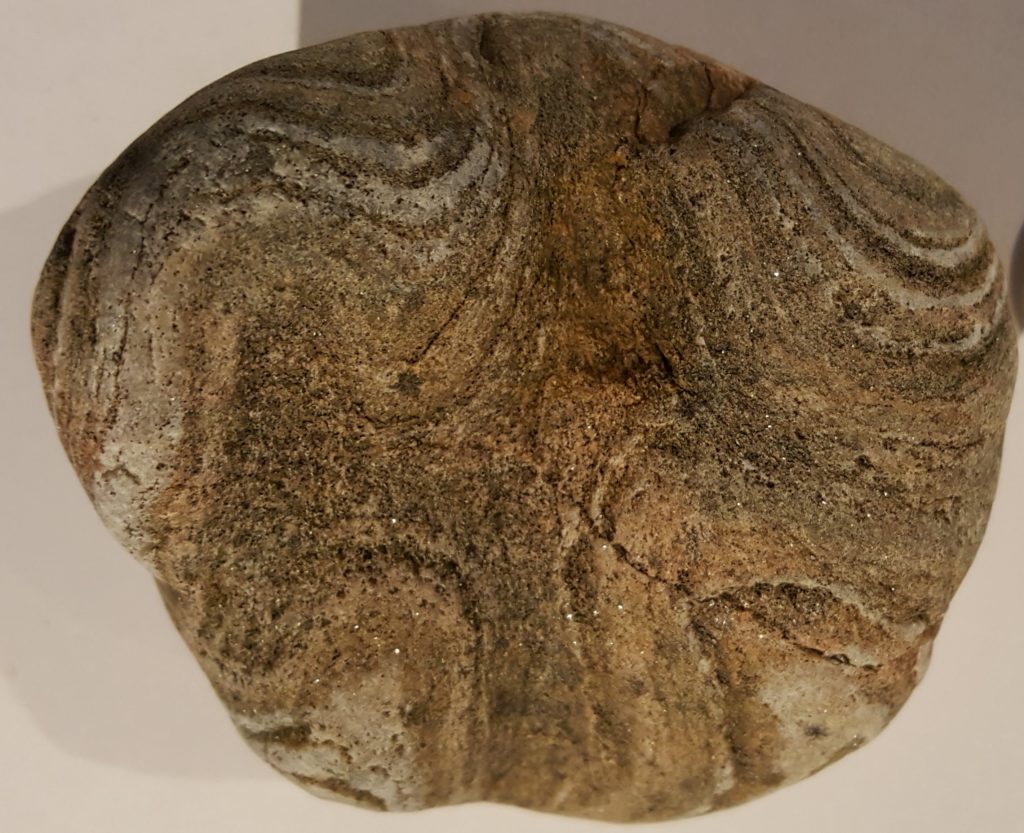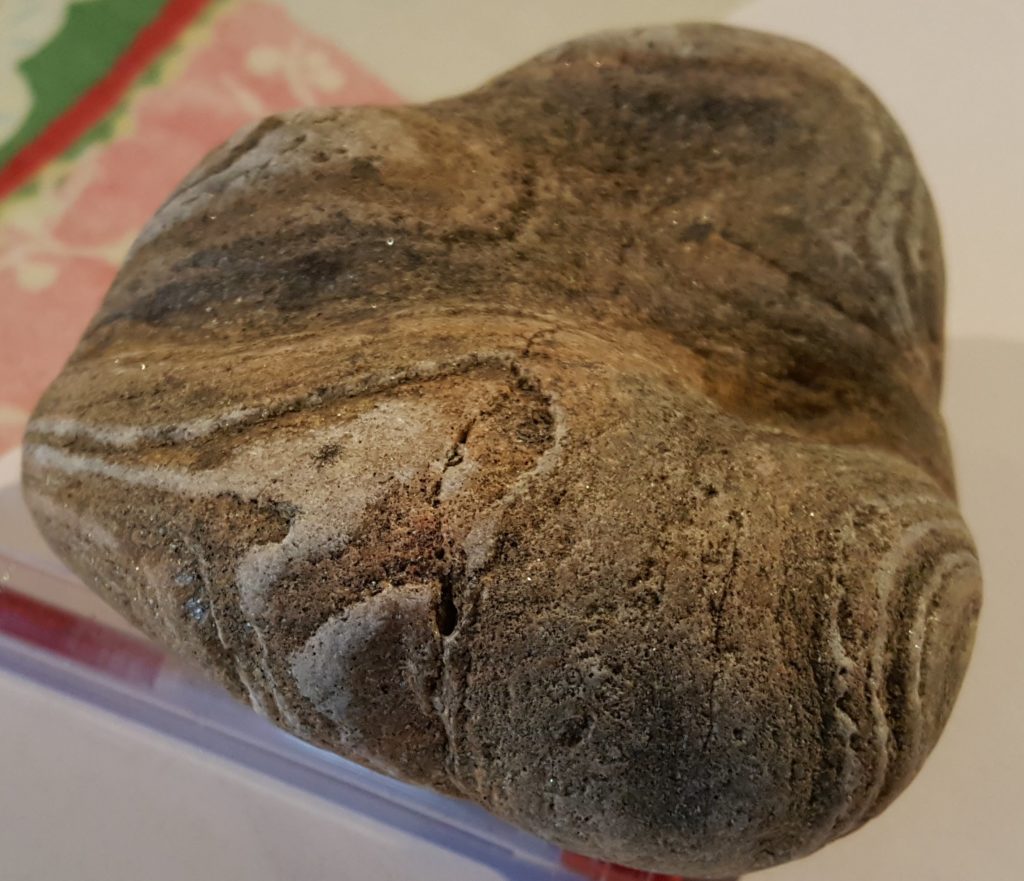In a companion post I introduced you to a metamorphic rock with an apparently simple history. Using traditional geological techniques on this single outcrop can’t reveal the full history of the area, so this post will attempt summarise the latest research. In short the more closely you look, the more complicated things become.
The many Phases of the Caledonian
When I was young, things were simple. The metamorphic rocks of the Scottish Highlands, (the Moine and Dalradian) were affected the by Caledonian orogeny caused by the closing of the Iapetus Ocean. A nice simple piece of continental collision with classic Barrovian metamorphism and some splendid deformation. Nowadays, thanks to isotopic dating we know that things are much more complicated. Much much more.
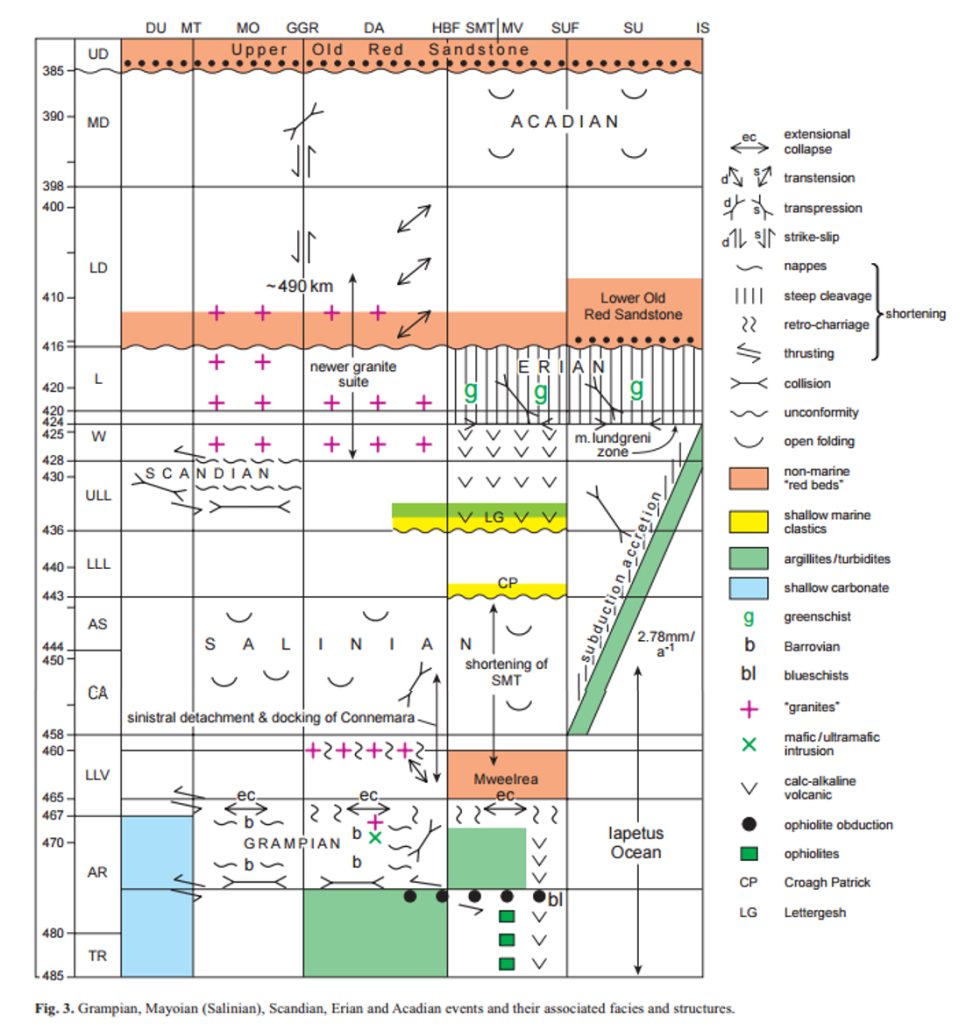
From Dewey et al 2015. Our rock is from the Moine, which is represented by the second column from the left
The diagram above represents the latest thinking about what the Caledonian Orogeny consisted of. Instead of a single continuous event we can recognise 3 distinct events each of which is associated with deformation and the growth of metamorphic minerals.
It comes from a paper that is a grand summary covering the entire British Isles. For today, let’s just focus on the second column from left, with Mo for Moine at the top. Start from the bottom and move up in time. First we have the Grampian event around 470 million years ago. It was caused by a collision between the edge of the Laurentian continent and an volcanic arc, with a piece of oceanic crust (an ophiolite) thrown in for good measure. I’ve written about this in detail elsewhere.
The second event, marked in the diagram as Salinian is less well understood. In the text Dewey et al. also call it the Mayoian as the deformation is well represented in County Mayo in Ireland (also perhaps because this was John Dewey’s PhD field area and he’s long been in love with the place). The alternative name Salinian (or Salinic) suggests a link with events of the same age in rocks from Newfoundland (which before the Atlantic was not far away). Dewey et al. speculate it may have been caused by subduction slab flattening (like the Laramide orogen in North America).
Bird et al. (2013) recognises the same event, dating growth of garnets at this time in rocks only about 25 km away from our rock sample. They call the event “Grampian II”, which is less poetic but avoids potentially incorrect correlations with other areas. Their proposed cause is the collision of a small fragment of crust or arc with Laurentia.
The final event is called the Scandian, which represents the final closure of the Iapetus ocean. In this northerly portion of the British Isles, this means a collision between the ancient continents of Laurentia (most of modern day North America, plus a sliver of NW Scotland) and Baltica (the ancient piece of crust that sits under modern day Scandinavia). Further north in the Moine, the dominant deformation fabrics are of this age, including the famous Moine Thrust.

Figure 5 from Bird et al. (2013) showing plate tectonic cross-sections at various times – b) is Grampian, c) Grampian II and d) is Scandian.
With one eye on the diagram above, lets describe those 3 events in terms of plate tectonics. First the Iapetus ocean opens up. Our rock is on one side, part of a plate called Laurentia. The ocean starts to close, but as it does so if forms an oceanic island arc. Around 470 Ma this collides with Laurentia heating and deforming a bunch of rocks. Twenty million years later, a smaller fragment (maybe like Rockall bank in the modern Atlantic) hits and causes some disturbance. Finally around 430 million years ago the ocean basin closes and messes some rocks up (again).
Which of these events caused the little feldspars to grow in my rocks sample? I don’t know for certain and what’s worse, it might not be any of them – it might be an older event.
When the Iapetus ocean opened at the beginning of my little story, the Moine rocks had already been deformed and heated at least twice before.
Before Iapetus
Cawood et al. (2012) is my main source of information here. Let’s cut to the chase and go straight for the summary diagram.
This is a similar diagram to the Dewey one above only it shows the actual dates from individual rocks. Similar dates exist for the younger events, but they are not shown on the first diagram.
I’ve reached my quota of explaining orogenies for the day. Let’s just say that there are two more here (Renlandian and Knoydartian), both poorly understood but both opportunities for my rock sample to have grown its feldspars.
What does it all mean?
What should we make of all this complexity? A few thoughts follow.
Firstly, the practice of correlating metamorphic or deformation events between different areas should be used with care – it can be completely wrong. The dominant fabric and metamorphic event in the northern Moine is Scandian in age, but in places further south it is Grampian II / Mayoian in age, despite looking very similar in thin section. Traditional analysis has correlated the two, but modern dating techniques show then to have formed at different times.
Secondly, if metamorphic minerals grew in the Moine at five different times, why doesn’t my rock show five sets of mineral growth? There are many possible reasons, but most importantly it’s likely that not all episodes affected all of the Moine – with the Scandian for example is possible that my area was too far from the action to be affected. Either geographically or possible because it was too high up in the crust.
It’s possible that later episodes of growth have completely destroyed earlier mineral grains, wiping the evidence away and making the rock’s history look simple. But we only know about each episode because we’ve dated a mineral grain that has remained relatively unscathed since. Rocks nearby still have visible sedimentary features retained so there are limits to how much we can explain this way.
Some believe that metamorphic events may transform relatively small volumes of rock because heating or fluid flow is localised. Outside of these areas, dry rocks are heated but don’t recrystallise – don’t change. A piece of pottery is a form of metamorphic rock transformed from mud, but heating it up again doesn’t cause a further dramatic change. Maybe my rock was transformed early on when it was rich in water from metamorphic reactions, but when heated up at a later date, little changed.
A third topic is around structure. There are no complex structures in my rock sample and its outcrop, but the Moine as a whole is a classic locality for refolded folds, which are exactly what you’d expect in an area deformed multiple times. Individual areas may have up to 4 different phases of folding, but the relationship between these and each orogeny is not simple. Bird et al. discuss this topic (about another area) and suggest fabrics or folds may be composite, that “structures may have initially developed as tight to open structures during the Late Ordovician event, and were later strongly modified into their present tight to isoclinal, sheath-like geometry during intense shear associated with Scandian nappe stacking“.
Many of discussions around metamorphism are relevant here as well. Let’s remember the undeformed sedimentary features in rocks nearby. They may now be vertical, but they are otherwise little deformed.
So how old are these blasted feldspars anyway?
Krabbendam et al. (2014), studying Moine rocks not far north of mine regard early structures (D1) as being pre-Grampian and later ones – and the main phase of mineral growth – as being Grampian II in age.
So that’s the most likely answer for my rock. Whatever happened in the pre-Grampian events is lost in the mists of time. Those nice big white feldspars grew and were rotated during the Grampian II event and shrugged off the Scandian event without any visible changes.
If you are thinking I’ve made this unnecessarily complicated I’ll just point that on a hillside visible from my outcrop there are some of the rocks that were the basement on which the Moine sediments were deposited. These ‘Lewisianoid’ rocks, now ‘inliers’, or strips of gneiss folded into the Moine metamorphic rocks, have experienced all of the events the Moine has, plus three or more others (Scourian, Laxfordian and Grenvillian). Here’s a thin section of some, with folded banding, but not looking *that* complicated, considering the 8 different events it’s witnessed.

Life is complicated. Plate tectonics is a continuous process that takes place in three dimensions on a sphere over millions of years. The fact we can use a bunch of ancient rocks in Scotland to recreate the ancient dance of vanished oceans and transformed continents is a triumph of science, but let’s not be surprised that it is complicated.
REFERENCES
Note that Professor Rob Strachan of Plymouth Portsmouth University is a co-author on nearly all of these papers. His nickname of ‘Captain Caledonides’ is well-earned.
Dewey, J. F., Dalziel, I. W., Reavy, R. J., & Strachan, R. A. (2015). The Neoproterozoic to Mid-Devonian evolution of Scotland: a review and unresolved issues. Scottish Journal of Geology, 51(1), 5-30. doi: 10.1144/sjg2014-007
Bird, A. F., Thirlwall, M. F., Strachan, R. A., & Manning, C. J. (2013). Lu–Hf and Sm–Nd dating of metamorphic garnet: evidence for multiple accretion events during the Caledonian orogeny in Scotland. Journal of the Geological Society, 170(2), 301-317. doi:10.1144/jgs2012-083
Cawood, P. A., Strachan, R. A., Merle, R. E., Millar, I. L., Loewy, S. L., Dalziel, I. W., … & Connelly, J. N. (2015). Neoproterozoic to early Paleozoic extensional and compressional history of East Laurentian margin sequences: The Moine Supergroup, Scottish Caledonides. Geological Society of America Bulletin, 127(3-4), 349-371. doi: 10.1130/B31068.1;
Krabbendam, M., Leslie, A. G., & Goodenough, K. M. (2014). Structure and stratigraphy of the Morar Group in Knoydart, NW Highlands: implications for the history of the Moine Nappe and stratigraphic links between the Moine and Torridonian successions. Scottish Journal of Geology, 50(2), 125-142. doi: 10.1144/sjg2014-002
All diagrams reproduced under fair use policy.
